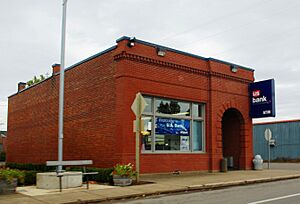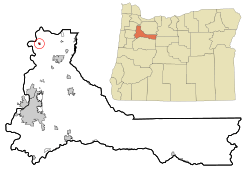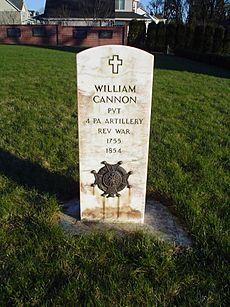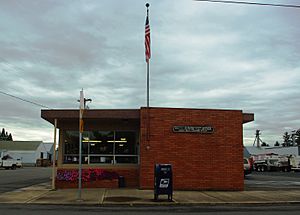St. Paul, Oregon facts for kids
Quick facts for kids
St. Paul, Oregon
|
|
|---|---|

U.S. Bank branch in the city
|
|

Location in Oregon
|
|
| Country | United States |
| State | Oregon |
| County | Marion |
| Incorporated | 1901 |
| Area | |
| • Total | 0.29 sq mi (0.76 km2) |
| • Land | 0.29 sq mi (0.76 km2) |
| • Water | 0.00 sq mi (0.00 km2) |
| Elevation | 171 ft (52 m) |
| Population
(2020)
|
|
| • Total | 434 |
| • Density | 1,476.19/sq mi (569.49/km2) |
| Time zone | UTC-8 (Pacific) |
| • Summer (DST) | UTC-7 (Pacific) |
| ZIP code |
97137
|
| Area code(s) | 503 and 971 |
| FIPS code | 41-64850 |
| GNIS feature ID | 2411763 |
St. Paul or Saint Paul is a small city in Marion County, Oregon, in the United States. It was named after the Saint Paul Mission. This mission was started by Archbishop François Norbert Blanchet, who came to the Oregon Country in 1838. He wanted to serve the Catholic people living in an area called French Prairie. In 2020, the city had 434 people. St. Paul is part of the larger Salem Metropolitan Statistical Area.
Contents
History of St. Paul
Settlers in French Prairie built a simple log church in the St. Paul area in 1836. On January 6, 1839, Father Blanchet held the first Catholic mass in Oregon at this church. He blessed the log church and named it after St. Paul.
The St. Paul Roman Catholic Church was built in 1846. It is the oldest brick building in the entire Pacific Northwest region.
The St. Paul post office opened in 1874. The city officially became a city in 1901.
Pioneer Cemetery: Resting Place for Early Settlers
The St. Paul Pioneer Cemetery was started in 1839. It is the burial site for William Cannon. He is the only confirmed Revolutionary War veteran buried in Oregon. William Cannon arrived in Oregon in 1811 with John Jacob Astor's American Fur Company. His grave is the only one in the cemetery with an upright headstone. Only one other grave has a marker; the rest were accidentally removed in the 1930s.
Besides Cannon, 535 other early settlers and Native Americans are buried here. These include Étienne Lucier, known as "The Father of Oregon Agriculture." Also buried are François Rivet and Philippe Degre, who said they were part of the Lewis and Clark Expedition. Rivet had traveled with the expedition to Fort Mandan. Degre joined the group when they spent the winter there in 1804–1805.
A wall of remembrance was added to the cemetery in 2005. Members of the Confederated Tribes of the Grand Ronde Community of Oregon were honored guests at its dedication. Many early French Canadian settlers married women from local tribes. These tribes included the Clackamas, Molala, and Kalapuya.
Archbishop Blanchet was first buried in the pioneer cemetery. Later, his remains were moved to St. Paul Catholic Cemetery. This new cemetery is a few blocks away and was founded in 1875. It has a special area called "Nuns Corner." Several sisters who were first buried in a convent garden were reburied there. Early settler and lawmaker William J. Bailey is also buried in the new cemetery.
Geography of St. Paul
The United States Census Bureau says that St. Paul covers about 0.29 square miles (0.76 square kilometers). All of this area is land.
The city is located near Mission Creek. This creek flows into Champoeg Creek, which then flows into the Willamette River.
Population and People
| Historical population | |||
|---|---|---|---|
| Census | Pop. | %± | |
| 1910 | 103 | — | |
| 1920 | 160 | 55.3% | |
| 1930 | 148 | −7.5% | |
| 1940 | 183 | 23.6% | |
| 1950 | 226 | 23.5% | |
| 1960 | 254 | 12.4% | |
| 1970 | 347 | 36.6% | |
| 1980 | 312 | −10.1% | |
| 1990 | 322 | 3.2% | |
| 2000 | 354 | 9.9% | |
| 2010 | 421 | 18.9% | |
| 2020 | 434 | 3.1% | |
| U.S. Decennial Census | |||
Who Lives in St. Paul?
In 2010, there were 421 people living in St. Paul. These people made up 147 households and 113 families. The city had about 1,452 people per square mile. There were 151 housing units, or homes, in the city.
Most residents, about 94.1%, were White. About 0.5% were Native American. About 4.8% were from other races, and 0.7% were from two or more races. About 14.7% of the population was Hispanic or Latino.
In the households, 43.5% had children under 18 living with them. About 66.0% were married couples. A small number of households had a female (6.1%) or male (4.8%) head without a spouse. About 23.1% were not families. The average household had 2.86 people, and the average family had 3.28 people.
The average age in the city was 38 years old. About 30.9% of residents were under 18. About 12.4% were 65 years or older. The population was almost evenly split between males (49.2%) and females (50.8%).
Arts and Culture
Annual Events and Festivals
The famous St. Paul Rodeo takes place every 4th of July. It has been held since 1935. This rodeo is one of the 20 largest rodeos in the United States. In 1991, the Professional Rodeo Cowboys Association called it the best rodeo in the Pacific Northwest.
Also, every summer, the Professional Bull Riders holds a smaller event in St. Paul. It is part of their Touring Pro Division (TPD).
Historic Places to Visit
The center of St. Paul was added to the National Register of Historic Places (NRHP) in 1982. It is known as the St. Paul Historic District. This district includes 63 important buildings. The St. Paul Catholic Church is the main attraction. It is also listed separately on the NRHP.
Education
St. Paul has a public school district with two schools. St. Paul Elementary School teaches students from Pre-K through 6th grade. St. Paul Middle & High School serves students from 7th grade through 12th grade.
There is also a private school called St. Paul Parochial School. It teaches students from Pre-K through eighth grade. This parish school was started in 1844 by six Sisters of Notre Dame de Namur. The sisters ran the school until 1853. In 1861, the Sisters of the Holy Names of Jesus and Mary took over. They ran the school until the 1980s. From 1993 to 2000, the school was run by the Sisters of St. Mary of Oregon.
Transportation
Oregon Route 219 is a state highway that goes through St. Paul.
Notable People
- Herman Pillette (1895–1960), a baseball player.
See also
 In Spanish: St. Paul (Oregón) para niños
In Spanish: St. Paul (Oregón) para niños





